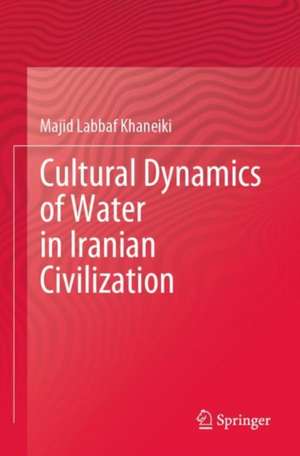Cultural Dynamics of Water in Iranian Civilization
Autor Majid Labbaf Khaneikien Limba Engleză Paperback – 25 sep 2021
| Toate formatele și edițiile | Preț | Express |
|---|---|---|
| Paperback (1) | 548.95 lei 38-44 zile | |
| Springer International Publishing – 25 sep 2021 | 548.95 lei 38-44 zile | |
| Hardback (1) | 638.43 lei 3-5 săpt. | |
| Springer International Publishing – 24 sep 2020 | 638.43 lei 3-5 săpt. |
Preț: 548.95 lei
Preț vechi: 686.19 lei
-20% Nou
Puncte Express: 823
Preț estimativ în valută:
105.04€ • 109.95$ • 87.43£
105.04€ • 109.95$ • 87.43£
Carte tipărită la comandă
Livrare economică 27 martie-02 aprilie
Preluare comenzi: 021 569.72.76
Specificații
ISBN-13: 9783030589028
ISBN-10: 3030589021
Pagini: 155
Ilustrații: X, 155 p. 32 illus., 10 illus. in color.
Dimensiuni: 155 x 235 mm
Ediția:1st ed. 2020
Editura: Springer International Publishing
Colecția Springer
Locul publicării:Cham, Switzerland
ISBN-10: 3030589021
Pagini: 155
Ilustrații: X, 155 p. 32 illus., 10 illus. in color.
Dimensiuni: 155 x 235 mm
Ediția:1st ed. 2020
Editura: Springer International Publishing
Colecția Springer
Locul publicării:Cham, Switzerland
Cuprins
Introduction.- Production and Water Culture.- Hydro-Political Organization.- Hydro-social cohesion.- Drought Pump.- The Water Delusion.
Textul de pe ultima copertă
This book traces “water” back to the most primitive animistic notions that are still lingering on in the shape of such rituals as qanat marriage or rain-making. Water, in the Iranian philosophy, is used in an attempt to find an explanation for the genesis of the universe, as described in Zoroastrian Akhshij philosophy, according to which water is one of the four fundamental elements of the creation. The concept of time began to germinate in the Iranian mind, when they had to count the passage of time in order to divide their scarce water resources. Water became so omnipresent in Iranian culture that it reached even the most mysterious seclusion of the Sufi monks. In Iran’s local communities, water culture is a thread that runs through different types of production systems. This book goes beyond indigenous water knowledge and traditional irrigation techniques, and conceptualizes water as a pivotal element of Iran’s social identity, cultural dynamics and belief systems, whereit examines the role of intermittent droughts in engendering and diffusing intangible cultural elements across the Iranian plateau. This book delves into Iran’s political organizations most of which were ensnared in a water-dependent lifecycle constituting a historical pattern described in this book as “hydraulic collapse” .
Caracteristici
Provides new information obtained through years of field studies in Iranian villages Examines intangible water culture from an interdisciplinary point of view Brings the readers to the deeper layers of water rituals through historical-geographical interpretations
